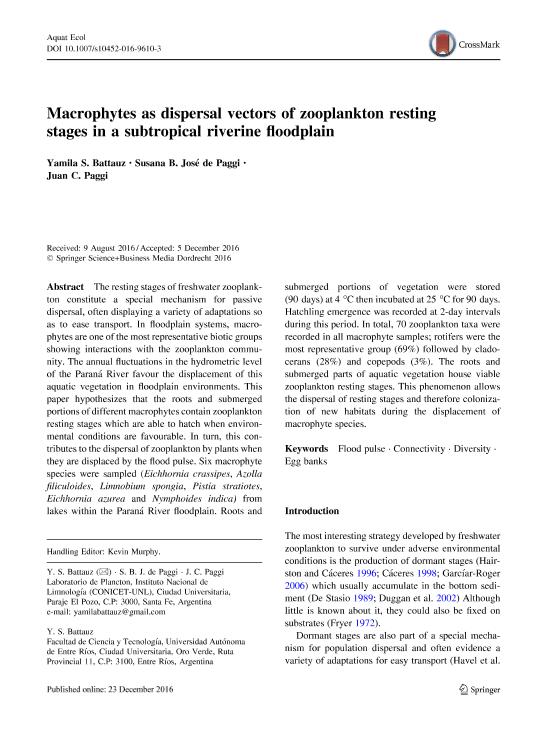Artículo
Macrophytes as dispersal vectors of zooplankton resting stages in a subtropical riverine floodplain
Fecha de publicación:
06/2017
Editorial:
Springer
Revista:
Aquatic Ecology
ISSN:
1386-2588
Idioma:
Inglés
Tipo de recurso:
Artículo publicado
Clasificación temática:
Resumen
The resting stages of freshwater zooplankton constitute a special mechanism for passive dispersal, often displaying a variety of adaptations so as to ease transport. In floodplain systems, macrophytes are one of the most representative biotic groups showing interactions with the zooplankton community. The annual fluctuations in the hydrometric level of the Paraná River favour the displacement of this aquatic vegetation in floodplain environments. This paper hypothesizes that the roots and submerged portions of different macrophytes contain zooplankton resting stages which are able to hatch when environmental conditions are favourable. In turn, this contributes to the dispersal of zooplankton by plants when they are displaced by the flood pulse. Six macrophyte species were sampled (Eichhornia crassipes, Azolla filiculoides, Limnobium spongia, Pistia stratiotes, Eichhornia azurea and Nymphoides indica) from lakes within the Paraná River floodplain. Roots and submerged portions of vegetation were stored (90 days) at 4 °C then incubated at 25 °C for 90 days. Hatchling emergence was recorded at 2-day intervals during this period. In total, 70 zooplankton taxa were recorded in all macrophyte samples; rotifers were the most representative group (69%) followed by cladocerans (28%) and copepods (3%). The roots and submerged parts of aquatic vegetation house viable zooplankton resting stages. This phenomenon allows the dispersal of resting stages and therefore colonization of new habitats during the displacement of macrophyte species.
Palabras clave:
Connectivity
,
Diversity
,
Egg Banks
,
Flood Pulse
Archivos asociados
Licencia
Identificadores
Colecciones
Articulos(INALI)
Articulos de INST.NAC.DE LIMNOLOGIA (I)
Articulos de INST.NAC.DE LIMNOLOGIA (I)
Citación
Battauz, Yamila Soledad; de Paggi, Susana B. José; Paggi, Juan Cesar; Macrophytes as dispersal vectors of zooplankton resting stages in a subtropical riverine floodplain; Springer; Aquatic Ecology; 51; 2; 6-2017; 191-201
Compartir
Altmétricas




